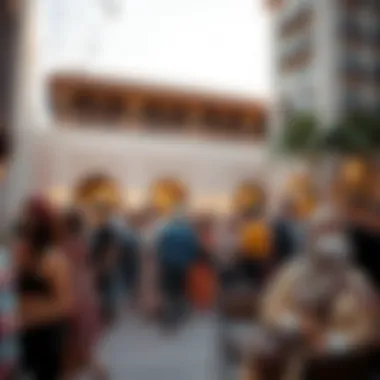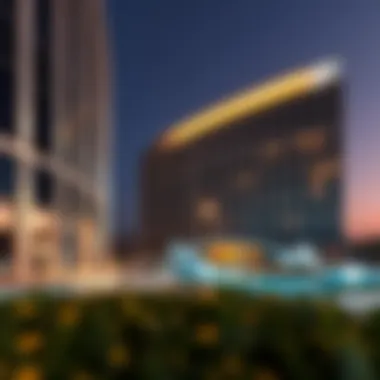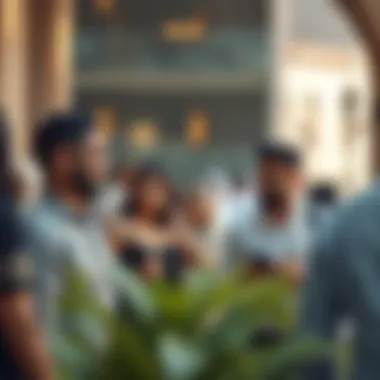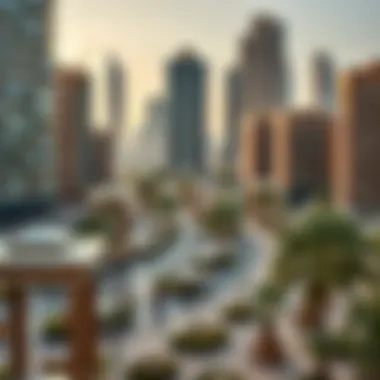Understanding صالة الشهامة in Modern Dubai


Intro
The term صالة الشهامة often carries layers of meaning that reflect more than just a physical space. It embodies the essence of communal interaction, showcasing the values of hospitality and togetherness deeply ingrained in the cultural fabric of societies, particularly in the Gulf region. In bustling cities like Dubai, where modernity and tradition intertwine, the significance of such communal spaces becomes ever more vital. This exploration seeks to dive into what صالة الشهامة actually means, its role in shaping societal dynamics, and how it influences the architectural landscape of contemporary urban life.
Dubai, known for its vast skyline and diverse population, showcases a unique blend of the modern and the cultural. Within this pulsating metropolis, صالة الشهامة stands as a testament to the values of community and interpersonal relations, often becoming a focal point for social gatherings. From families celebrating milestones to neighbors forging connections, these spaces foster an environment where dialogue and camaraderie flourish.
As we unravel the layers of أسماء الشهامة, we highlight key themes. A look into market trends reveals how real estate development is tailored to accommodate these communal hubs, while investment opportunities present intriguing prospects for both newcomers and long-time residents. Through a wide-angle lens, we will explore how the principles behind صالة الشهامة serve as guiding pillars for community cohesion and architectural innovation.
Let's delve deeper into the evolving landscape of communal spaces by checking the Market Trends.
Understanding صالة الشهامة
Understanding صالة الشهامة requires diving into its multiple layers—historical, cultural, and social. This section serves as the foundation for grasping why this concept is so essential in today’s world, especially within the vibrant fabric of Dubai. By exploring its definition, cultural significance, and role in community life, we gain full insight into how صالة الشهامة influences not only architectural design but also the way communities interact with each other.
Definition and Origins
The term صالة الشهامة translates to a large hall or communal space that often represents values like honor, nobility, and hospitality. Its origins can be traced back to traditional practices in Gulf Arab culture, where such venues provided a space for gatherings, celebrations, and important discussions among community members. Traditionally, صالة الشهامة served as the heart of the community, reflecting shared values and cultural heritage.
Moreover, it is not merely a physical structure but also embodies a philosophy of connection and togetherness. By creating a dedicated space for interactions, صالة الشهامة encourages dialogue and strengthens bonds among community members. These spaces often adapt and evolve reflecting the various influences that shaped their inception.
Cultural Significance
Culturally, صالة الشهامة acts as a mirror through which the values of generosity and support can be observed. It signifies a welcoming environment where visitors can experience the community’s commitment to hospitality. For expatriates and newcomers to Dubai, entering a صالة الشهامة can be a rite of passage; it often symbolizes their acceptance into a broader social circle.
The integration of صالة الشهامة within the cultural practices of the region highlights its importance in fostering unity and understanding. Events like weddings, festivals, and family gatherings occur here. It’s not just about space; it’s a living testament to communal identity, showcasing local traditions, cuisine, and art. Such spaces play a pivotal role in safeguarding the cultural heritage of the region while adapting to modern dynamics.
The Role of صالة الشهامة in Community Life
In community life, صالة الشهامة occupies a central role as a hub for social activities. Think of it as a communal living room where important conversations take place. This space often hosts meetings and discussions that can shape local governance and community projects. It's a place where ideas flourish, and mutual understanding is cultivated.
Additionally, the role of صالة الشهامة extends beyond just social events; it fosters collaboration and community resilience in an ever-changing urban environment. For instance, during crises or emergencies, these spaces can transform into resource centers or shelters for those in need, showcasing the adaptability inherent to their purpose.
In summary, understanding صالة الشهامة isn’t just about pinpointing a cultural identity. It’s about recognizing how these communal spaces serve as catalysts for interaction and cooperation within the societal framework of Dubai, exemplifying both tradition and modernity.
Architectural Elements of صالة الشهامة
The architectural elements of صالة الشهامة are vital as they encapsulate the essence of community gathering spaces. These elements go beyond mere aesthetics; they reflect cultural identity and foster social interactions. Understanding how these components come together can offer deeper insight into how communal activities thrive within these architectures.
Design Considerations
When designing a صالة الشهامة, the focus should be on creating an environment that promotes comfort and accessibility. Several factors need to be evaluated:
- Spatial Layout: The arrangement of spaces must encourage interaction while providing areas for privacy. Open layouts often serve well for larger gatherings, whereas smaller alcoves may foster intimate conversations.
- Natural Light: Incorporating ample windows or skylights can make a space feel inviting and cheerful. Studies show that natural light improves mood and promotes social activity.
- Functionality: A صالة الشهامة should be versatile. The design should accommodate a variety of functions— from formal meetings to casual family gatherings. Having movable partitions can ensure the space adapts to its usage.
- Cultural Symbology: Infusing design elements that reflect local culture instills a sense of belonging. Patterns or motifs relevant to the community can seamlessly blend traditional architecture with modern design.


Materials Used
The choice of materials in صالة الشهامة can dramatically impact its functionality and aesthetic appeal. Here are critical materials often used:
- Natural Stone: Materials like limestone or marble not only enhance durability but also add an element of elegance.
- Wood: Wood can bring warmth to the space. Sustainable options are becoming preferred choices, reflecting a growing awareness of environmental impacts.
- Glass: Using glass for walls or partitions provides transparency, creating a feeling of openness. It also boosts natural light, further enhancing the ambiance.
- Textiles: Incorporating textiles in seating or decorative elements can add comfort and contribute to the overall atmosphere.
Integration with Urban Spaces
To successfully integrate صالة الشهامة with urban spaces, architects must consider several elements:
- Access and Connectivity: The location should be easily accessible via public transport or walking paths. This encourages more community members to engage.
- Landscaping: Surrounding green spaces can complement the structure, offering a serene environment. Parks or gardens nearby may be a great addition to host outdoor activities.
- Mixed-use Development: Ideally, a صالة الشهامة should coexist with commercial and residential spaces. This encourages a dynamic interaction among diverse community members.
- Cultural Landmarks: Placing the صالة الشهامة near historical or cultural landmarks can enrich the experience, or even serve as a focal point for community events.
"The design of a صالة الشهامة should resonate with the community’s values and aspirations, acting as a canvas for social interaction and cultural heritage."
Social Dynamics Within صالة الشهامة
The concept of صالة الشهامة transcends its architectural boundaries, serving as a pivotal element in shaping social dynamics within the community. It is not merely a physical space but a symbol of connection, cultural exchange, and mutual understanding among diverse groups of people. In an increasingly globalized world, the patterns of interaction, the nature of events held, and the influence on personal relationships within these spaces foster a sense of belonging and communal identity.
Interaction Patterns
In صالة الشهامة, interaction patterns reveal much about community values. People come together here to engage in conversations that span various topics, from daily life to cultural discussions. This mingling of thoughts creates a rich tapestry of perspectives.
There’s no denying that the design of صالة الشهامة encourages this interaction. The open layout, characterized by large seating arrangements and gathering areas, promotes informal gatherings. This structure empowers individuals to strike up conversations with others they may not typically interact with, thus breaking down social barriers.
Key features influencing interaction patterns include:
- Open-space layouts: Encouraging organic conversation flow.
- Central communal areas: These act as natural hubs where people congregate.
- Flexible furniture arrangements: Allow for adaptability in social gatherings.
Thus, the social tone set in صالة الشهامة allows for the formation of new friendships, varying opinions, and the cultivation of respect for diverse backgrounds. It’s a melting pot of sorts, where interactivity becomes the heart of the experience.
Events and Gatherings
Events held in صالة الشهامة resonate with community spirit and highlight shared customs. Whether it’s a wedding, cultural celebration, or a casual get-together, these occasions illustrate the social fabric that binds the community tightly together. Each event is not just a mere gathering; it embodies collective memories and traditions that individuals hold dear.
Typically, events involve:
- Cultural celebrations: Showcasing local traditions and folklore.
- Educational gatherings: Inviting speakers or guests to discuss pertinent community issues.
- Social support groups: Providing a forum for tackling shared concerns or ideas.
During these gatherings, the atmosphere becomes electric, filled with laughter, storytelling, and the exchange of life experiences. They not only create memories but also foster a deeper understanding and identity among attendees, thereby solidifying relationships.
Influence on Relationships
The role of صالة الشهامة in influencing relationships cannot be overlooked. This communal hub fosters an environment where friendships are nurtured, and relationships are deepened. By providing a space for interaction and events, it allows individuals to evolve their connections organically over time.
As people meet regularly in this intimate environment, they tend to share not just moments but also experiences and values. This shared venture fosters:


- Trust: Built through shared stories and experiences.
- Cohesion: Strengthening community ties amongst diverse groups.
- Network building: Creating bonds that extend beyond soft social interactions into real-world collaborations.
Overall, صالة الشهامة helps shape the relationships that define the community, from friendships to business partnerships. It is in these spaces that true connections are forged, ones that can sustain a community through thick and thin.
In essence, صالة الشهامة is a mirror reflecting the intricate web of social dynamics, where every interaction, gathering, and relationship contributes to a broader narrative of community life.
With a deeper understanding of the social dynamics within صالة الشهامة, we can appreciate how this space transforms individuals and unifies a community, reinforcing the essence of shared values and identities within contemporary urban life.
Impact of Modern Developments on صالة الشهامة
Modern developments significantly shape the concept and function of صالة الشهامة, reflecting the dynamic culture of urban spaces in Dubai. This interaction is complex, influenced by rapid technological advancements, shifting social norms, and evolving community perspectives. These elements collectively enhance the role of صالة الشهامة, making it a cornerstone for interaction in the community.
Technological Advancements
In recent years, technology has made its presence felt in nearly every aspect of life, and صالة الشهامة is no exception. From smart home integrations to high-speed internet access, the technological landscape is evolving. For instance, the inclusion of digital screens for updates on community events transforms static announcements into dynamic information hubs.
Furthermore, virtual reality can bring distant family members or friends into these communal spaces via video calls, allowing for interaction that mimics physical presence. Using applications for event scheduling not only streamlines communication but also fosters a culture of engagement. The blend of tradition and modernity allows صالة الشهامة to cater to a tech-savvy generation while keeping its cultural roots intact.
Changing Social Norms
Changes in social attitudes impact every corner of society, including how community spaces like صالة الشهامة are utilized and understood. Traditionally, صالة الشهامة represents a male gathering place, acting as a hub for decision-making, storytelling, and cultural exchange. However, the norms are shifting, as more women and younger generations look to integrate into these social spaces. The modern interpretation of صالة الشهامة has broadened to be more inclusive, exemplifying the communal nature that transcends age and gender.
With women voicing their thoughts and participate in these discussions, community forums and gatherings are becoming platforms where all views are valued. This shift brings new ideas and dynamism, fostering a more collaborative environment. The once rigid concepts surrounding these spaces are now fluid, facilitating a richer community interaction that aligns with societal progress.
Evolving Perspectives on Community
As urban life continues to change, so do the underlying perceptions of what constitutes a community. The modern-day صالة الشهامة reflects these shifts by adopting a more multifaceted approach to community interaction. The function of these spaces has evolved from being a mere gathering spot to become essential in fostering community resilience and collective problem-solving.
New initiatives that encourage cultural events, local artistry, and workshops bring diverse groups together, serving as a melting pot of ideas and lifestyles. This transformation prompts a recognition that صالة الشهامة can serve as a catalyst for positive change, embracing community identity while encouraging growth and unity.
In summary, the impact of modern developments on صالة الشهامة is profound. Through technological integration, evolving social norms, and changed perspectives on community, these spaces are becoming more relevant than ever. Acknowledging these developments not only honors the tradition of صالة الشهامة but also invites new ways of thinking that will shape its future.
Comparative Frameworks of صالة الشهامة
The exploration of صالة الشهامة is enriched when we place it within a comparative framework. This broader context not only illuminates the distinctive features of صالة الشهامة but also aligns it with global concepts that serve similar social and cultural functions. Within this section, we will delve into the significance of these comparative frameworks, highlighting key aspects that contribute to a richer understanding of صالة الشهامة in relation to other communal spaces around the globe.
Comparisons with Similar Concepts Globally
In many cultures, communal spaces often serve as focal points for social interaction, much like صالة الشهامة. While the term might be unique to certain regions, the underlying principles manifest in various forms worldwide. For instance, the Japanese community center—akin to a shōtengai—emphasizes a collective spirit, facilitating gatherings and fostering relationships among residents.
- Cultural Community Centers: In regions like South America, plazas are central to community life, much like صالة الشهامة, acting as venues for events, markets, and celebrations.
- European Town Squares: These squares promote a sense of community, echoing the essence of صالة الشهامة through shared experiences and local traditions.
By analyzing these structures, we can appreciate the universal need for spaces that nurture relationships and cultural ties. The key differences often lie in the purpose and methods by which communities engage within these environments, an area worth exploring further.
Learning from Other Cultures


Examining صالة الشهامة alongside similar spaces opens the door to valuable lessons from different cultural landscapes. Every community has crafted its own approach to fostering connection, and by understanding these frameworks, we can glean insights that inform future developments for صالة الشهامة.
- Adapting Successful Elements: For instance, the Scandinavian concept of Friluftsliv (open-air living) encourages outdoor activities that strengthen bonds among individuals. This could inspire an integration of more greenery and open-air elements within صالة الشهامة to promote well-being and social interaction.
- Resilience in Design: Observing Mediterranean markets reveals how flexible seating arrangements and movable stalls facilitate mingling and socializing. Incorporating similar design strategies into صالة الشهامة might enhance its role as a community hub.
By borrowing ideas from various cultures, صالة الشهامة can evolve, retaining its cultural significance while adapting to contemporary needs and advancements. This blending promotes a vibrant exchange of social values, enhancing the overall community experience and ensuring it remains relevant in an ever-changing landscape.
In essence, the comparative analysis of صالة الشهامة against global concepts illuminates its unique role while also offering pathways for growth and improvement, pivotal for future community engagement.
Future Perspectives on صالة الشهامة
The concept of صالة الشهامة is not merely a relic of cultural heritage but is steadily evolving into a significant component of urban life. As cities undergo rapid transformation, understanding how صالة الشهامة fits into future urban landscapes is essential. It will influence how communities interact, engage, and ultimately thrive in an increasingly interconnected world. Moreover, keeping an eye on future perspectives aids stakeholders, such as investors, realtors, and urban planners, in making informed decisions that align with sustainable and social goals.
Sustainability and Green Design
As society becomes more environmentally conscious, the push for sustainability in urban design is becoming critical. صالة الشهامة can be a template for sustainable community spaces by integrating green design principles. This involves using environmentally friendly materials such as reclaimed wood, bamboo, or recycled steel in their construction.
Patterns show that spaces designed with sustainability in mind foster enthusiasm in communities, encouraging active participation in preserving the environment. The introduction of green roofs or community gardens in these areas can promote biodiversity and strengthen community ties.
"Sustainable development is about more than just buildings; it’s about creating environments where communities can flourish together."
Incorporating renewable energy solutions such as solar panels or wind turbines can provide these community spaces with self-sufficiency, reducing reliance on external power sources. Not only does this contribute to a lower carbon footprint, but it also serves as an educational tool about sustainability for community members, particularly the younger generation.
Role in Urbanization Trends
Today's urbanization trends present both opportunities and challenges for صالة الشهامة. As cities grow, there's a pressing need for spaces where people can connect, reflect, and collaborate. An effective صالة الشهامة can bridge the gap between traditional values and modern needs, providing common ground for diverse populations. This adaptability is crucial, especially in cosmopolitan areas like Dubai, where the demographic landscape is continually shifting.
Moreover, as development expands, these spaces have the potential to become multi-functional. They can host events, serve businesses, or provide services that cater to both locals and expatriates. Understanding these trends allows stakeholders to adapt صالة الشهامة to reflect the changing desires of the community, ensuring that they remain relevant and utilized. The integration of smart technology, such as digital kiosks for information or mobile apps for event scheduling, can further refine the interaction between space and its users.
Community Resilience and Adaptive Strategies
Inherently, صالة الشهامة is about community resilience. As neighborhoods face various adversities—be it economic downturns, social unrest, or environmental challenges—a well-formulated صالة الشهامة can stand as a beacon of hope and unity. Through adaptive strategies, these spaces can be modified to meet the evolving needs of the population.
Engaging community members in decision-making processes regarding their local صالة الشهام�ة can enhance its resilience. When people have a say in how their community space is shaped, they’re more likely to feel ownership, leading to increased participation and care for the space. This collaborative approach not only entails formal structures but also organic gatherings that allow spontaneous bonding and local culture to thrive.
Additionally, resilience can be reinforced through partnerships with non-profits or governmental bodies to focus on disaster preparedness and recovery, particularly in regions susceptible to natural calamities. In such a manner, صالة الشهامة will continue to serve as an essential hub for support and recovery, demonstrating its lasting impact on the social fabric of the community.
End
The concept of صالة الشهامة is not just a cultural catchphrase; it embodies the essence of community, the heart of social interaction, and the backbone of urban living in places like Dubai. A review of this article underscores not only the significance of these spaces in fostering relationships but also their adaptability in a rapidly changing social landscape.
Key Takeaways
- Cultural Heritage: The صالة الشهامة represents a vital connection to cultural roots, reminding individuals of their shared values and communal traditions.
- Architectural Design: Understanding the elements that define صالة الشهامة helps architects and designers create spaces that are not only functional but also resonate with the community’s identity.
- Social Cohesion: Engaging in gatherings and events within these halls fosters social bonds, leading to stronger, cohesive communities.
As highlighted, the importance of this topic lies in its ability to reflect the integration of modernity with tradition. Investors and realtors, for example, can leverage this knowledge to enhance property value, knowing that homes with proximity to such spaces offer more than just a roof—they provide a sense of belonging.
Community spaces like صالة الشهامة are vital for collective identity.
Final Thoughts on صالة الشهامة
Ultimately, the exploration of صالة الشهامة reveals that these communal halls are much more than physical structures; they are woven into the social fabric of life in Dubai and beyond. They adapt to technological advancements while remaining steadfast to cultural significance. The evolution of social norms affects how these spaces are used, but their fundamental role in fostering connections stays intact.



